Miss Fury: Sensational Sundays 1941-1944
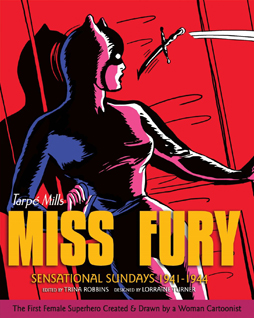 In 1941 comics artist June Tarpé Mills started a new Sunday adventure strip: Miss Fury. It would run until 1952, telling the wild and beautifully-drawn saga of a socialite who donned a magical black cat-suit to fight Nazis and criminals. In 2011 IDW’s Library of American Comics imprint published a selection of Miss Fury strips from 1944 through 1949, edited and with an introduction by comics historian Trina Robbins. Last year Robbins and IDW published a second volume, collecting the series from the start up to the beginning of the earlier collection, again featuring an introduction about Mills and her strip, and as well a brief selection of some of Mills’ earlier work. I had a chance to read the recently-published second collection, and was tremendously impressed.
In 1941 comics artist June Tarpé Mills started a new Sunday adventure strip: Miss Fury. It would run until 1952, telling the wild and beautifully-drawn saga of a socialite who donned a magical black cat-suit to fight Nazis and criminals. In 2011 IDW’s Library of American Comics imprint published a selection of Miss Fury strips from 1944 through 1949, edited and with an introduction by comics historian Trina Robbins. Last year Robbins and IDW published a second volume, collecting the series from the start up to the beginning of the earlier collection, again featuring an introduction about Mills and her strip, and as well a brief selection of some of Mills’ earlier work. I had a chance to read the recently-published second collection, and was tremendously impressed.
To start with what is most immediately obvious: the book’s a feast for the eyes. Not only is Mills’ art spectacular, but the reproduction brings out the richness of the linework and often-stunning colours. Designed by Lorraine Turner, the book is quite beautiful. The paper’s obviously whiter and brighter than newsprint, but the colours still feel appropriate, bright and yet often detailed.
Certainly Mills’ art deserves good treatment. Her work is beautiful, with a sumptuous eye for costume and detail, as well as crisp action. The story is fast-paced pulp adventure at full blast — shadowed New York cityscapes and Brazilian jungles, fist-fights and gun-battles and aerial dogfights, violence and a surprising amount of sex and blood. It’s wildly entertaining, with characters breathtakingly broad and unlikely, easily navigating the line where the ridiculous and the awesome meet.
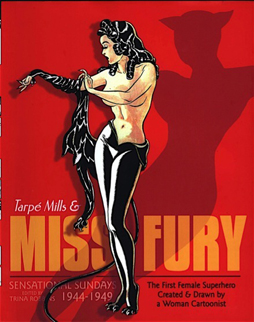 Mills was twenty-six when she first started to work in comics. According to a 1942 profile of Mills in The New York Post, she’d had a prior job as an animator until, as she said, “I was carried out of the joint with a nervous breakdown.” She ended up in comic books: “Then a foot injury kept me out of circulation and I started a serial called ‘Daredevil Barry Finn’ for one of the children’s comic books. I hated to drop Barry, so I went into the business whole hog and turned out such hair-raising thrillers as ‘The Purple Zombie,’ ‘Devil’s Dust,’ and ‘The Cat Man.’”
Mills was twenty-six when she first started to work in comics. According to a 1942 profile of Mills in The New York Post, she’d had a prior job as an animator until, as she said, “I was carried out of the joint with a nervous breakdown.” She ended up in comic books: “Then a foot injury kept me out of circulation and I started a serial called ‘Daredevil Barry Finn’ for one of the children’s comic books. I hated to drop Barry, so I went into the business whole hog and turned out such hair-raising thrillers as ‘The Purple Zombie,’ ‘Devil’s Dust,’ and ‘The Cat Man.’”
These were four-page stories for magazines like Amazing Mystery Funnies and Funny Pages. In 1941 she started the weekly Miss Fury strip, distributed by the Bell Syndicate. She managed to retain copyright, and from 1942 to 1946 it was reprinted by Timely Comics (as the company now known as Marvel Comics was then called). Mills went by her middle name to hide her gender — the Post quotes her as saying “It would have been a major let-down to the kids if they found out that the author of such virile and awesome characters was a gal” — and mostly retired from comics when Miss Fury ended, though she did return in 1971 with Our Love Story from Marvel. Mills died in 1988, having made comics history: Miss Fury was the first costumed super-heroine created by a woman.
The comic is incredibly readable. Marla Drake first puts on her black cat-suit, a gift from an uncle, as a costume for a fancy party — and immediately finds herself involved in a hunt for an escaped murderer. That’s wrapped up, but events spiral on, leading her to don the costume again and again. Miss Fury (originally the Black Fury) soon runs into Nazi agents, notably the Baroness Erica von Kampf and General Bruno, and then is drawn into the search for a mysterious artificial metal. Meanwhile, Marla finds herself romantically split between her longtime boyfriend Gary Hale and driven police detective Dan Carey who seeks to apprehend the mysterious Miss Fury. Things only grow more complex when the scene shifts to Brazil, where General Bruno is planning an uprising to coincide with a German invasion.
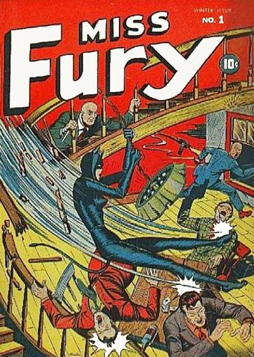 It’s fast and highly inventive. Marla’s got no special fighting powers, but the action scenes are so well-thought-out they feel credible. The plot depends on coincidence, as the cast of characters run into each other again and again, but this is the sort of story where unlikely coincidences that throw twists into the plot are to be expected; they add to the fun. Those twists aside, Mills’ writing is effective and clever, the set-pieces well-staged and elaborate when they need to be.
It’s fast and highly inventive. Marla’s got no special fighting powers, but the action scenes are so well-thought-out they feel credible. The plot depends on coincidence, as the cast of characters run into each other again and again, but this is the sort of story where unlikely coincidences that throw twists into the plot are to be expected; they add to the fun. Those twists aside, Mills’ writing is effective and clever, the set-pieces well-staged and elaborate when they need to be.
Her handling of her chosen narrative structure is excellent, as well. Almost every page in the book is a grid of four tiers of three panels each; the first panel is the title block. You can see Mills work out quickly how to handle a page, and what its rhythms are as a unit of story. She typically starts a page abruptly, feeds any needed exposition early on, and builds to a crescendo or cliffhanger on the last panel. Dialogue is extensive, but highly readable and never excessive. This is clearly a classical page structure, but it works.
That’s almost a surprise; it’d be very easy for the similarly-shaped pages of similarly-sized panels to become monotonous. But it never does. Mills moves her camera sharply, varying angles and dropping in silent panels and generally guiding the eye nicely across the page. Sometimes the occasional text-heavy page even helps, focussing the attention on the purely verbal instead of the visual. American comics were still at a relatively early stage when Mills began Miss Fury, but the strip strikes me as assured and still very effective in its storytelling.
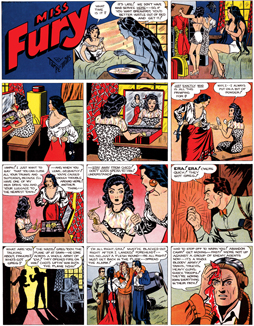 Frankly, it helps that Mills is such a good artist. You see her develop as the book goes on — notably she becomes more confident in using shadow — but her artwork’s elegant right from the start. She has a confident, fluid line, and a realistic sensibility that makes room for cartoony touches; Miss Fury’s eyes are blanks. Her characters have distinct body language, their postures always natural yet expressive. But the strip really lives in its faces, I think, emotive and distinctive and often quite beautiful. Mills is able to capture great complexity in a single facial expression, giving the strip a real emotional heft.
Frankly, it helps that Mills is such a good artist. You see her develop as the book goes on — notably she becomes more confident in using shadow — but her artwork’s elegant right from the start. She has a confident, fluid line, and a realistic sensibility that makes room for cartoony touches; Miss Fury’s eyes are blanks. Her characters have distinct body language, their postures always natural yet expressive. But the strip really lives in its faces, I think, emotive and distinctive and often quite beautiful. Mills is able to capture great complexity in a single facial expression, giving the strip a real emotional heft.
Which isn’t to say that it’s realist drama by any stretch. It’s a full-bore adventure comic, with suspense and page-to-page cliffhangers. Still, it’s not just filled with action, but with consequences to the violence, with death and injury. And blood, come to that; there’s a lot of gore here for a family newspaper. But then there’s also a surprising amount of skin — Mills’ beautiful women are always changing clothes and taking baths. There’s even some off-panel sex clearly and very cleverly implied. It doesn’t feel exploitative, at least to me, but it is noticeable.
Clearly, though, Miss Fury is primarily a pulp-style action strip, and it delivers on that score. There’s weird science and mad doctors and the supernatural — it’s strongly implied there’s something magical and perhaps cursed about Miss Fury’s outfit. Characters are always getting into fights. Surprisingly, Marla doesn’t don her costume that often; as Robbins observes in her introduction, Mills seems to become fascinated by her villains. Locked together in weird love-hate relationships, they double-cross each other again and again, taking centre stage in the strip for long periods. Perhaps Mills realised something about the nature of a hero strip: the hero, the character the strip’s named after, is relatively safe — but anything goes with the villains. They can be scarred or maimed or killed as needed. The stakes are higher.
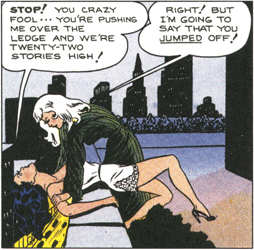 And surely one of the strengths of the book is that Mills gets across the sense of great stakes. You feel the characters are in real jeopardy. Anything can happen, and when an action scene or fight scene starts, you have no idea how it’s going to end. So the story’s also unpredictable, and yet not shapeless; there is an overall feel of things building. There’s no real ending, at least not in this book, but the characters move through what feels like an unending tapestry of adventure, changing as they go.
And surely one of the strengths of the book is that Mills gets across the sense of great stakes. You feel the characters are in real jeopardy. Anything can happen, and when an action scene or fight scene starts, you have no idea how it’s going to end. So the story’s also unpredictable, and yet not shapeless; there is an overall feel of things building. There’s no real ending, at least not in this book, but the characters move through what feels like an unending tapestry of adventure, changing as they go.
If Mills avoids putting her character in costume too often, I wonder if that’s a function of her working out what kind of story she wants to tell, and how the new genre of costumed adventurers works with that. Mills seems to be consciously working in the tradition of pulp adventurers like The Shadow, but costumed heroes were still relatively new in comics (which themselves were relatively new in American mass culture). The Phantom had debuted only five years before, and I wonder whether that was a direct influence on Mills; like the Phantom, Miss Fury has no pupils when in costume, and has a mystical connection to Africa — though, at least in this book, she never travels there.
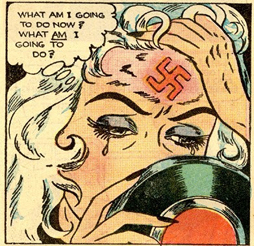 Perhaps more interesting is the question of how deeply Miss Fury influenced later comics. At a glance, you can see that her costume is reminiscent of the later design of DC’s Catwoman, who had been around since 1940, but only put on a cat costume in 1947. That outfit was only vaguely similar to Miss Fury’s, but the design in the 1966 TV show was closer, and the design in Frank Miller’s 1987 Batman: Year One series almost exactly the same. The catsuit also bears a passing similarity to the costume of DC’s Wildcat, who debuted not long after Miss Fury in a book cover-dated January 1942 (meaning it was probably on sale in late 1941). But in fact it looks like Miss Fury had more of an influence than that.
Perhaps more interesting is the question of how deeply Miss Fury influenced later comics. At a glance, you can see that her costume is reminiscent of the later design of DC’s Catwoman, who had been around since 1940, but only put on a cat costume in 1947. That outfit was only vaguely similar to Miss Fury’s, but the design in the 1966 TV show was closer, and the design in Frank Miller’s 1987 Batman: Year One series almost exactly the same. The catsuit also bears a passing similarity to the costume of DC’s Wildcat, who debuted not long after Miss Fury in a book cover-dated January 1942 (meaning it was probably on sale in late 1941). But in fact it looks like Miss Fury had more of an influence than that.
Specifically, you can see an influence on some 1960s Marvel comics in these strips. That’s perhaps not entirely surprising, given that Timely reprinted the Miss Fury strips for a few years (although, on the other hand, for much of that time Stan Lee was serving in the US Army). In a general sense, you can say that the way Marla Drake’s personal and romantic lives cross over into her crimefighting capers is very similar to the structure of the early adventures of Peter Parker. As a more specific example, Marla fracturing her arm in an early sequence reminds me of a storyline in an early Spider-Man issue where Spider-Man sprained his arm; both characters had to hide from people in their civilian lives the injury they’d suffered while in costume. Beyond that: Marla’s mystical black cat-suit comes from “Africa” (no country is specified in these strips), while Marvel’s Black Panther is an African hero in a black cat-suit with some mystical abilities. Miss Fury investigates a mysterious artificial element that causes metal to melt, while in Daredevil 13, cover-dated February 1966, a similar anti-metal was introduced to the Marvel universe.
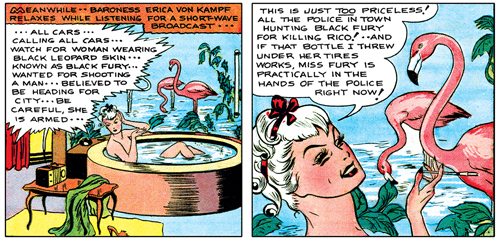 More even than that, though. Look at one of Marla’s antagonists, General Bruno. Bruno’s powerfully built, bald, with a monocle in his right eye and a scar down the left side of his face; he fights against a band of multi-national guerillas, including one named Fury, but plots to survive the collapse of the Nazi regime by building a new organization with himself at the head. All of those things can also be said of longtime Marvel villain Baron Strucker. Bruno’s a vivid character in his own right, but the resemblance is striking.
More even than that, though. Look at one of Marla’s antagonists, General Bruno. Bruno’s powerfully built, bald, with a monocle in his right eye and a scar down the left side of his face; he fights against a band of multi-national guerillas, including one named Fury, but plots to survive the collapse of the Nazi regime by building a new organization with himself at the head. All of those things can also be said of longtime Marvel villain Baron Strucker. Bruno’s a vivid character in his own right, but the resemblance is striking.
Still, while interesting, these connections are basically trivia. Miss Fury is a success in its own right. It’s a comic strip that deserves to be better-known and more accessible to readers than it has been. Before the two Robbins-edited books, there’d been no reprints of Miss Fury since 1979; I’m glad they’re around now. I will admit that I sometimes find old adventure strips difficult to appreciate in a more-than-abstract way — I can recognise the importance and stylishness of Terry and the Pirates while being completely indifferent to the story, for example. But Miss Fury is more engaging to me, the characters more vivid. I’m happy to have had the chance to read it.
Matthew David Surridge is the author of “The Word of Azrael,” from Black Gate 14. His ongoing web serial is The Fell Gard Codices. You can find him on Facebook, or follow his Twitter account, Fell_Gard.
[…] Miss Fury: Sensational Sundays 1941-1944 […]